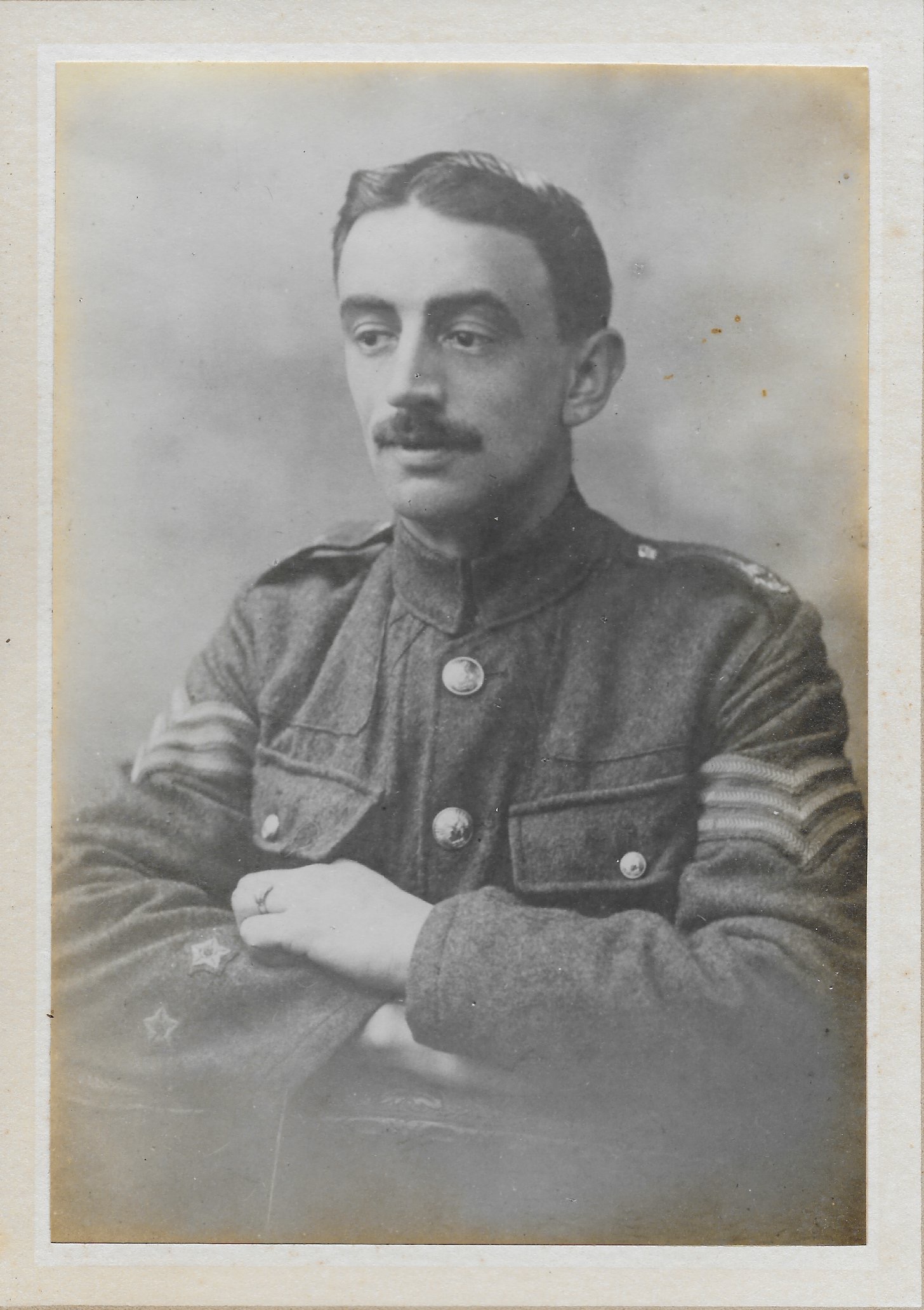Sjt
William John Latter
Informatie over geboorte
|
Geboortejaar: 1887 |
|
Geboorteplaats: Tunbridge Wells, Kent, Engeland, Verenigd Koninkrijk |
Algemene Informatie
|
Beroep: Gasfitter |
Informatie legerdienst
|
Land: Engeland, Verenigd Koninkrijk |
|
Strijdmacht: British Expeditionary Force |
|
Rang: Serjeant |
|
Service nummer: 265156 |
|
Dienstneming plaats: Tunbridge Wells, Kent, Engeland, Verenigd Koninkrijk |
|
Eenheden: — Queen's Own (Royal West Kent Regiment), 7th Bn. (Laatst gekende eenheid) |
Informatie over overlijden
|
Datum van overlijden: 12/10/1917 |
|
Plaats van overlijden: The Brewery, Poelkapelle, België |
|
Doodsoorzaak: Killed in action (K.I.A.) |
|
Leeftijd: 30 |
Gedenkplaats
|
Tyne Cot Memorial Paneel: 106 |
Onderscheidingen en medailles 2
|
British War Medal Medaille |
|
Victory Medal Medaille |
Points of interest 2
| #1 | Geboorteplaats | ||
| #2 | Dienstneming plaats |
Mijn verhaal
Serjeant William John Latter, a thirty-year-old gasfitter from Tunbridge Wells in Kent, was killed during the Battle of Passchendaele. William served with the 7th Battalion Queen’s Own (Royal West Kent Regiment), part of the 55th Brigade, of the 18th (Eastern) Division.
In October 1917, the 55th Brigade was ordered to take the surroundings of Meunier House, east of the ruins of Poelkapelle. The 7th Battalion relieved the 6th Battalion Yorkshire regiment on the night of 10 October. Due to the short notice of the attack and a lack of knowledge about the area, starting positions were adjusted some hours before the battle on the 11th October. The Royal West Kent Regiment was positioned near the Church and between Delta Houses and Retour Cross Roads. Their first objective was the Poelkapelle Brewery.
When William’s Battalion advanced the allied barrage fell too short and came crushing down on the 7th Queen’s flanks. This resulted in a number of casualties. The barrage was furthermore far from adequate and almost no German machine-guns were taken out. The Germans immediately opened heavy rifle- and machine-gun fire at close range. In a short period of time almost all officers and senior N.C.O’s of the Battalion had become casualties. Communication with the troops in the frontline was neigh to impossible, as runners couldn’t get back, due to the withering rifle- and machine-gun fire. It quickly became clear that, except for small parties on the left and right flank, almost no progress had been made.
Notwithstanding suffering heavy casualties, the 7th Queen’s were able to reach the Brewery, though no further advance was possible. At 8.50 p.m. orders were issued that the Battalions had to establish positions on the line held. The Royal West Kent Regiment was relieved on the following day.
William John Latter was killed in action on the 12th of October 1917, when his Battalion attacked the Brewery. William left behind a wife and three young children. He was among the 1200 casualties of the 55th Brigade in this battle. As William has no known grave he is remembered on the Tyne Cot Memorial.
In October 1917, the 55th Brigade was ordered to take the surroundings of Meunier House, east of the ruins of Poelkapelle. The 7th Battalion relieved the 6th Battalion Yorkshire regiment on the night of 10 October. Due to the short notice of the attack and a lack of knowledge about the area, starting positions were adjusted some hours before the battle on the 11th October. The Royal West Kent Regiment was positioned near the Church and between Delta Houses and Retour Cross Roads. Their first objective was the Poelkapelle Brewery.
When William’s Battalion advanced the allied barrage fell too short and came crushing down on the 7th Queen’s flanks. This resulted in a number of casualties. The barrage was furthermore far from adequate and almost no German machine-guns were taken out. The Germans immediately opened heavy rifle- and machine-gun fire at close range. In a short period of time almost all officers and senior N.C.O’s of the Battalion had become casualties. Communication with the troops in the frontline was neigh to impossible, as runners couldn’t get back, due to the withering rifle- and machine-gun fire. It quickly became clear that, except for small parties on the left and right flank, almost no progress had been made.
Notwithstanding suffering heavy casualties, the 7th Queen’s were able to reach the Brewery, though no further advance was possible. At 8.50 p.m. orders were issued that the Battalions had to establish positions on the line held. The Royal West Kent Regiment was relieved on the following day.
William John Latter was killed in action on the 12th of October 1917, when his Battalion attacked the Brewery. William left behind a wife and three young children. He was among the 1200 casualties of the 55th Brigade in this battle. As William has no known grave he is remembered on the Tyne Cot Memorial.
Bronnen 6
|
Ancestry https://search.ancestry.co.uk Gebruikte bronnen |
|
Atkinson, C. The Queen's Own Royal West Kent Regiment : 1914-1919. Londen: Simpkin, Marshall, Hamilton, Kent & Co., 1924, p. 296-299. Gebruikte bronnen |
|
CWGC https://www.cwgc.org/find-war-dead/casualty/835383/latter,-william-john/ Gebruikte bronnen |
|
Mc Carthy C., Passchendaele Day-by-Day account, Unicorn Publishing Group, 2018, London, p. 132-133. Gebruikte bronnen |
|
Naval Military Archives http://www.nmarchive.com/ Gebruikte bronnen |
|
The Long Long Trail http://www.longlongtrail.co.uk/army/regiments-and-corps/the-british-infantry-regiments-of-1914-1918/the-queens-own-royal-west-kent-regiment/ Gebruikte bronnen |
